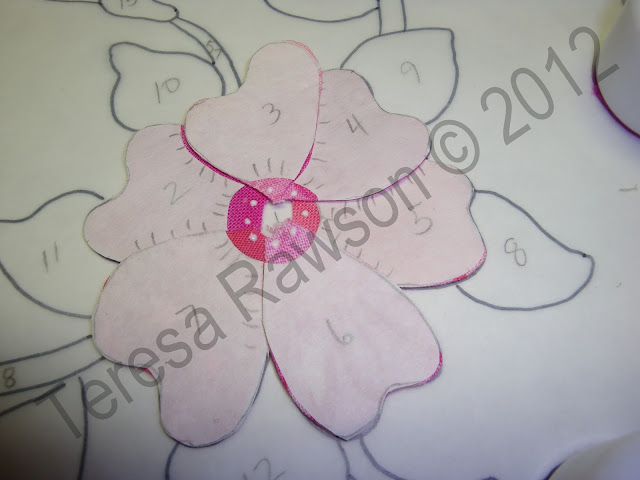The oboe is the next block in "Baltimore Rhapsody," a music quilt in the Baltimore album style that I am designing. It is the soprano member of the double reed instrument family... double reed because two pieces of thin, narrow reed are shaved and tied together with thread and placed in a holder affixed to the small end of the instrument. When blown, the softened, wet reeds vibrate to make the distinctive sound.
The modern oboe was invented in Paris, France about 300 years ago by a bagpiper in the court ballet orchestra, but it is based on similar ancient instruments. One of these, the Aulos, was popular in Greece and took much strength to play; the player's cheeks were strapped with a leather belt to keep them from bursting, LOL!

It is said that the instrument is not so much blown, but that the air is allowed to escape into the instrument to produce the sound (maybe that is why oboe players always appear a little tortured while they play...).
My high school band director used to tease that playing the oboe killed brain cells, due to all the back pressure in the head. Oh my! (I had expressed interest in the oboe...I think he was trying to discourage me...)
The oboe gives the "A" for all the other orchestra instrumentsto tune to. This is because altering the pitch of this instrument involves actual carpentry!
The pink Sweet Williams are made petal by petal, glue basted together with tiny dots of Roxanne's Glue Baste. Petals are prepped with a glue stick first, then the order of the addition of petals is based on which petals are "behind" and which petals are toward the "front."

I place the tiny dots of glue away from the intersection of the pieces so that I don't have to stitch through the dried glue later. I use this Roxanne's glue so that I don't have to work with pins.
I find this pre-assembly work very satisfying!
After the glue baste is dry enough, I carefully remove the ironed-on freezer paper patterns (they can be reused!) and hand applique the blossom together using YLI silk thread.
I lay out all my prepped pieces on the pattern to make sure I haven't missed any. I do as much of the unit assembly BEFORE working on the background as I can...I find it easier and more accurate working right on the pattern to "build" the motifs instead of trying to see the pattern through the background fabric square.
When all the units are glue basted and the larger ones stitched off block, I center the background square on the pattern so that the design is showing through as my guide (a light box makes this easier). Then I glue baste everything to the background square using as little glue as possible ("dot-dot-not-a-lot").
Here is one of the blossoms, all stitched together, ready to be placed on the background square, using a light box to reveal the pattern through the fabric. These blocks that I stitch off block are really portable for sewing away from the quilt cave.
At this point, I hand appliqued all the blossom, leaves, buds, and vines to the background square before adding the oboe. I just find it easier to applique the more involved instrument pieces when I'm not catching my thread on the unstitched edges of the flower pieces.
In stitches,
Teresa :o)





















































